Key takeaways:
- Understanding your motivation is essential for writers, as it fuels passion and helps navigate self-doubt.
- Setting clear, achievable writing goals transforms the writing process, making it more manageable and focused.
- Developing a consistent writing routine increases productivity and creativity while incorporating breaks prevents burnout.
- Building an authentic author brand through audience engagement and consistency is crucial for connecting with readers.
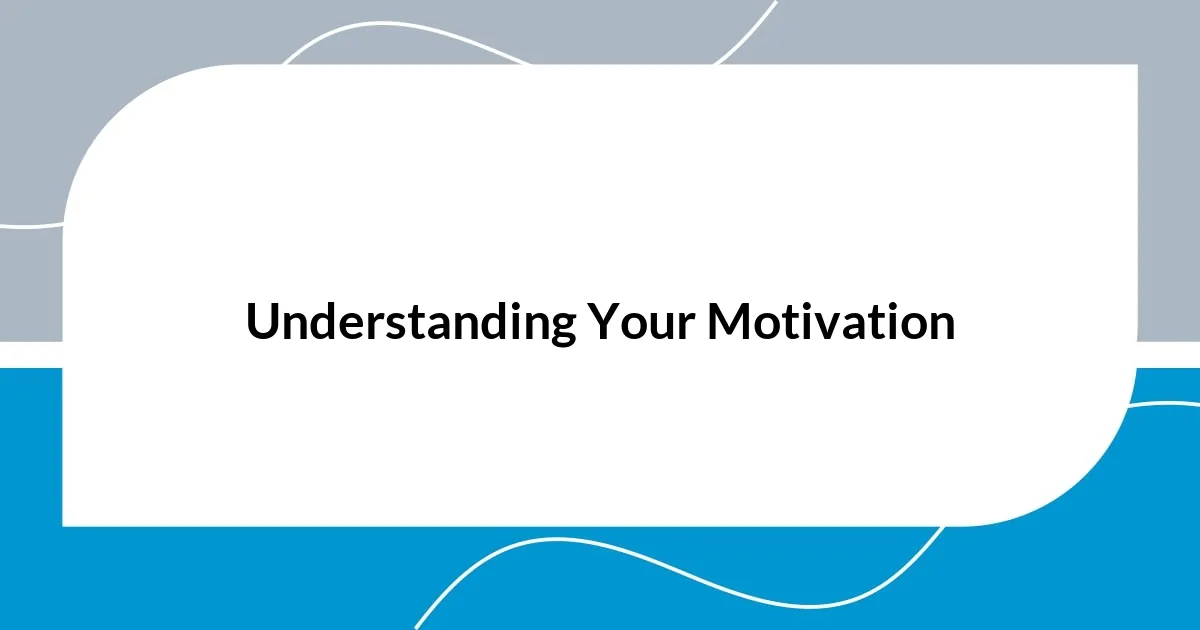
Understanding Your Motivation
Understanding your motivation is crucial on your journey to becoming an author. I remember sitting at my cluttered desk, staring blankly at a page, questioning why I wanted to write in the first place. Was it the love of storytelling, the desire to inspire, or maybe the need to connect with others? Reflecting on this helped me clarify my purpose, which fueled my passion to put my thoughts into words.
Often, I’ve found that motivation can shift and evolve. Some days, it’s the thrill of creating new worlds that drives me; other days, it’s the hope of sharing personal experiences that resonate with someone else. Have you ever felt that tug of a story inside you, begging to be released? That’s a powerful motivation that shouldn’t be ignored. Embracing these feelings not only nurtures your creativity but also helps you push through moments of self-doubt.
Taking time to understand what truly motivates you can be a game changer. Personally, I discovered that my motivation stemmed from a blend of personal healing and a desire to leave a mark on the world. When I write, I’m not just sharing stories; I’m sharing pieces of my journey. Connecting those dots can provide the drive you need during challenging times, reminding you why you started in the first place.
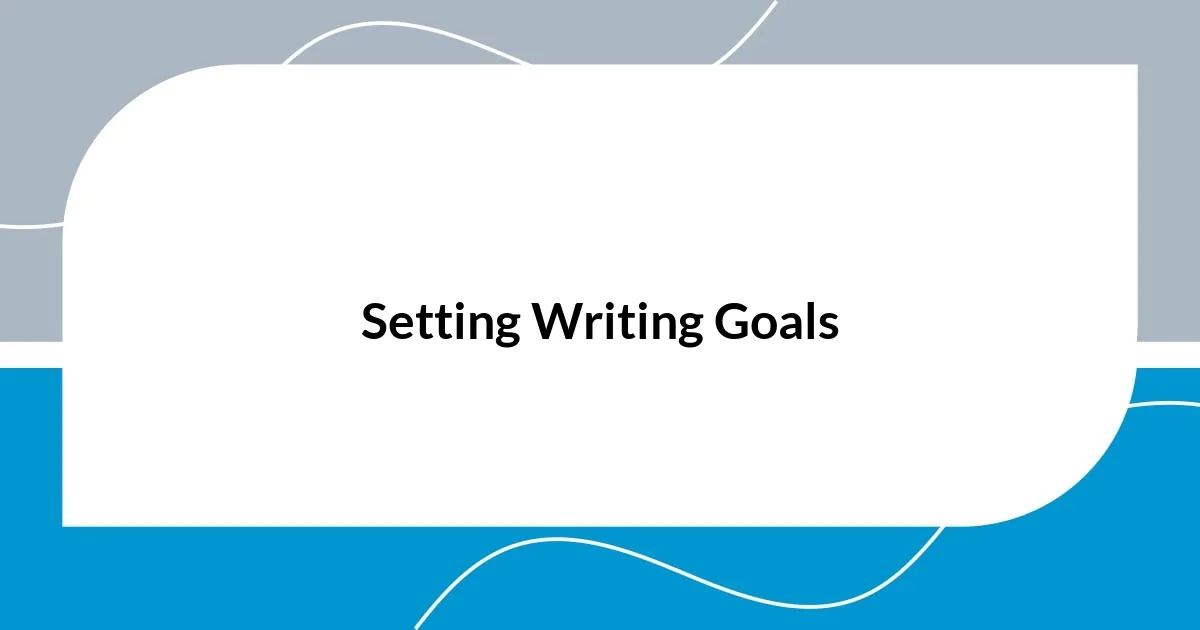
Setting Writing Goals
Setting clear writing goals has played a transformative role in my journey. When I first started, I often felt overwhelmed by the vastness of the writing world. I remember one night, staring at my notebook, frustrated because my thoughts seemed to float away like smoke. It was then that I realized creating specific, achievable goals could anchor my creativity. For me, setting these goals felt like designing a roadmap, guiding me through the sometimes chaotic landscape of writing.
Here are some strategies that have worked well for me in establishing my writing goals:
- Break It Down: Instead of aiming for a complete novel, I started with a daily word count. It made writing feel less daunting and more manageable.
- Set Deadlines: I remember giving myself a month to draft my first short story. This urgency pushed me to focus.
- Track Progress: Keeping a journal of my writing sessions helped me see how far I’d come, fueling my motivation.
- Mix It Up: I sometimes set goals for different genres or forms; switching styles keeps the excitement alive.
- Reflect and Adjust: After each project, I took time to reflect on my goals. Did they align with my evolving journey? Adjusting them kept me on track and inspired.
These tiny adjustments have not only sharpened my focus but have also cultivated a sense of accomplishment that fuels my passion for writing.
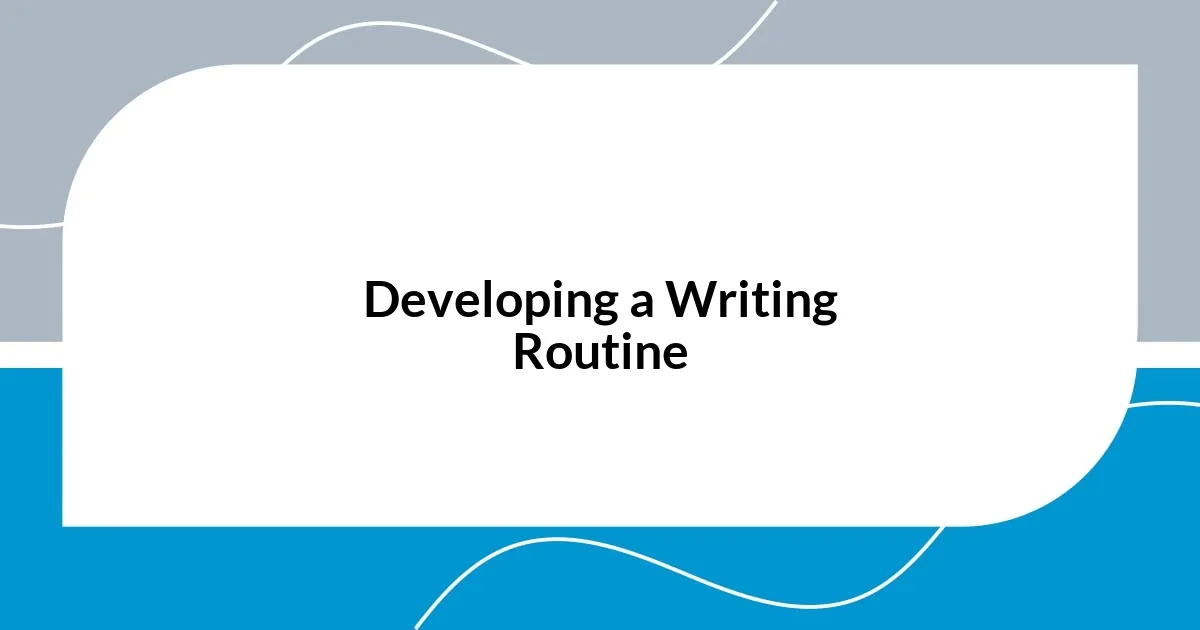
Developing a Writing Routine
Establishing a writing routine has been one of the most rewarding aspects of my journey as an author. Initially, I tried to write whenever inspiration struck, but I quickly realized that this was unpredictable and often led to dry spells. After some trial and error, I committed to writing every morning, just after breakfast. This consistency transformed my writing process, allowing my thoughts to flow more freely. I remember those early mornings; the sun barely peeking through the curtains while the world around me was still waking up. It was my personal sanctuary, and I found that having that dedicated time heightened my productivity.
As I developed my writing routine, I also discovered the importance of creating a conducive environment. I made my workspace comfortable and inviting, surrounding myself with the tools that inspire me—books, notepads, and even a little plant. This small change made a considerable difference. In those moments, I felt the magic of the writing process envelop me, leading me to explore stories I never knew I had inside. Have you ever experienced that rush of creativity when you’re in the right zone? It’s exhilarating!
I learned that incorporating breaks into my routine was just as crucial. I set a timer to write for 25 minutes, then stepped away for five minutes. This self-care practice reinvigorated my mind and helped to avert burnout. I vividly recall a day when I pushed through without a break, only to find myself staring blankly at the screen, frustrated. That experience taught me to respect the rhythm of my creativity. Listening to what my mind needed ultimately made my writing sessions far more enjoyable and productive.
| Aspect | Routine |
|---|---|
| Inspiration-Based | Writing whenever ideas struck, often leading to inconsistent output. |
| Time-Structured | Establishing a specific writing time, such as mornings, fostering consistency and focus. |
| Ad hoc Environment | Working in a disorganized space, making it harder to concentrate. |
| Organized Workspace | Creating an inviting area full of inspirational items enhances creativity. |
| No Breaks | Writing continuously, risking burnout and loss of inspiration. |
| Scheduled Breaks | Incorporating short breaks boosts creativity and keeps the mind fresh. |

Overcoming Writer’s Block
Writer’s block can feel like an insurmountable wall, but I’ve found that embracing those moments of struggle often leads to breakthrough. I remember a particularly frustrating week when every word I typed felt wrong, leaving me staring blankly at the screen. Instead of fighting it, I decided to step away and go for a long walk. That change of scenery cleared my mind, and I was suddenly flooded with ideas as if a dam had burst open. Isn’t it fascinating how a little distance can awaken our creativity?
Another effective strategy for me has been freewriting. I set a timer for ten minutes and let my thoughts spill onto the page without judgment. During one of these sessions, I found myself exploring deep-seated emotions I hadn’t even realized were affecting my writing. It was raw and liberating, and surprisingly, some of that honesty made its way into my work. Have you ever allowed yourself to write unfiltered? It can be incredibly freeing and lead to unexpected insights.
Sometimes, I’ve turned to my favorite books for inspiration when I feel utterly stuck. I remember curling up with a classic novel, immersing myself in the rhythm of the words. It reignited my passion and reminded me why I love storytelling. There’s something magical about getting lost in someone else’s narrative and finding threads of inspiration woven throughout. Have you ever found that a simple act, like reading, could break the chains of writer’s block? For me, it’s a powerful reminder that creativity isn’t just about the words we produce; it’s also about the stories that inspire us.
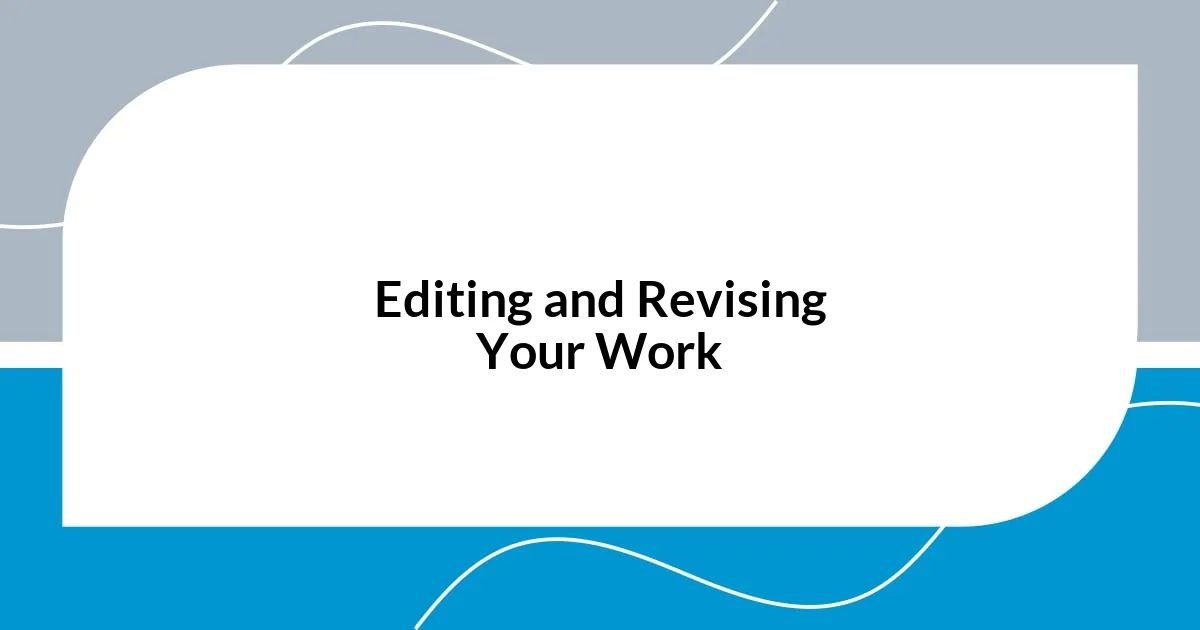
Editing and Revising Your Work
Editing and revising can be a transformative part of the writing process. When I first started, I dreaded this phase. I remember reading my initial drafts and feeling a mix of panic and disappointment. It took time for me to embrace the fact that these rough edges were simply pathways to clarity. Now, I view editing not as a chore, but as an opportunity to refine my voice and elevate my story. Isn’t it amazing how shedding unnecessary words can suddenly make your message shine?
One strategy that has really improved my editing skills is allowing myself some distance from the text. After completing a draft, I often step away for a day or two. I recall one time, I came back after a brief break and felt like I was reading someone else’s work. This fresh perspective enabled me to identify awkward phrasing and narrative inconsistencies that had previously evaded me. Have you ever had an experience where a little distance utterly changed your view? It taught me the value of looking at my work with fresh eyes; that break can be the key to uncovering hidden gems or realizing when something just doesn’t work.
Another crucial step in my editing process is reading my work aloud. I was skeptical at first, thinking it would be a waste of time. However, there was a moment when I stumbled over a sentence that sounded fine in my head but felt clunky when spoken. It was a revelation! This practice not only improves the flow of the text but also highlights emotional beats in the story that may need more attention. Have you ever tried reading your writing aloud? It’s like giving your words a performance, uncovering rhythm and resonance you might not have noticed otherwise.
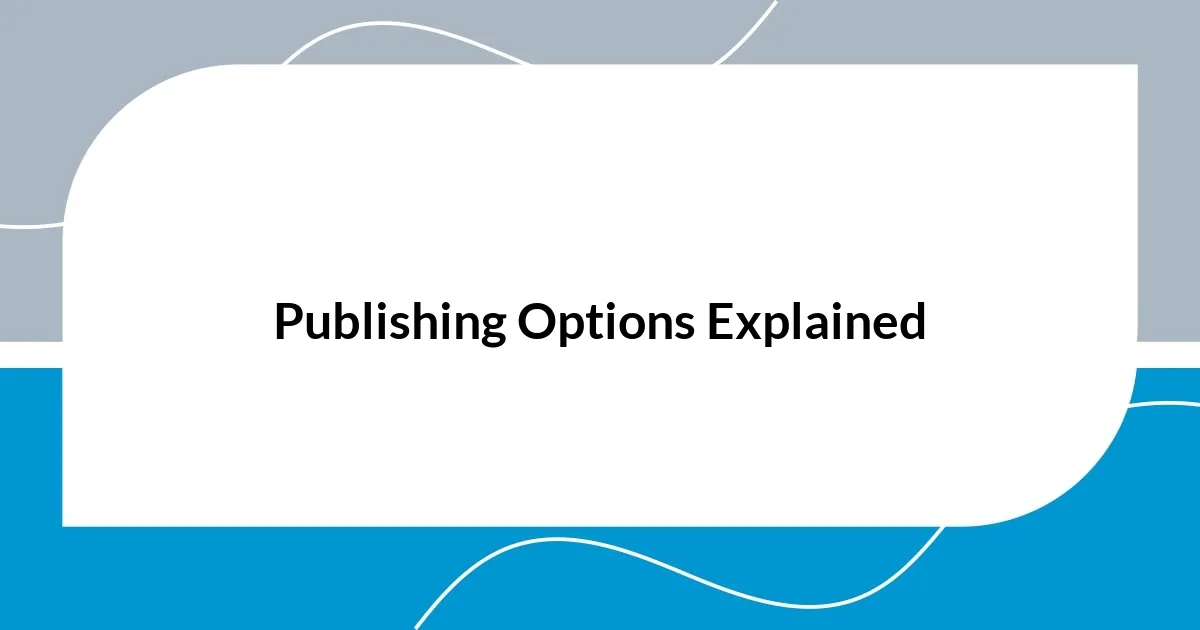
Publishing Options Explained
Choosing the right publishing option can feel overwhelming, especially when I first started out. I remember standing at that crossroads, torn between traditional publishing and self-publishing. I ultimately went with self-publishing, which allowed me full control over my work and the creative process. Have you ever experienced that thrill of making decisions that shape your story’s destiny? It was liberating for me.
Traditional publishing offers the allure of professional support, from editing to marketing. I had moments where I thought maybe I should submit my manuscript to agents. Just the idea of having industry professionals backing my writing was tempting. However, the long wait times and the uncertainty of getting a book deal nudged me toward self-publishing. It just felt more aligned with my personal vision and timeline. Have you considered how long you would want to wait for your book to reach readers?
Self-publishing isn’t just about putting your work out there; it’s also a learning experience. Each step, like designing a cover or strategizing my marketing plan, has been an eye-opener. I recall wrestling with cover design for hours—finding the right visuals to encapsulate my book’s essence was no small feat. Have you ever learned something new that transformed your approach to a project? I sure have, and it’s enriched my journey as an author in ways I never anticipated.

Building Your Author Brand
Building your author brand is a journey I deeply connect with. When I first started, I wanted to project an image of professionalism, yet it didn’t feel authentic to who I am. I remember creating my website and agonizing over what to include. Should I highlight my writing awards or perhaps showcase quirky personal tidbits? I soon realized that my brand should reflect my passion for storytelling and my unique voice. Have you ever felt caught between who you are and who you think you should be? Embracing my true self allowed me to create an author brand that resonates with readers.
One of the most pivotal moments in shaping my brand came from engaging with my audience on social media. When I launched my first book, I shared snippets of my writing process, which sparked genuine conversations. I found that readers were just as interested in the journey as they were in the finished product. I still remember a lovely message from a reader who, after reading about my struggles and triumphs, said my story inspired her to pursue her own writing. Has there been a time when someone’s words unexpectedly fueled your passion? For me, those connections were invaluable; they helped solidify my brand as one rooted in authenticity and community.
As I developed my brand further, I understood the importance of consistency. In the beginning, I juggled multiple social media platforms, often feeling scattered. It wasn’t until I focused on just a couple, refining my messaging and visuals, that I saw a real transformation. Now, when someone encounters my name, there’s a cohesive narrative that unfolds, making my author persona instantly recognizable. Have you ever wondered how a simple shift in focus can lead to clarity and impact? For me, it became a game-changer in building the lasting connections that every author strives for.